Welding in motorsports with Andy Weyenberg of Miller Electric
In this episode of The Fabricator Podcast, and in partnership with Miller Electric, Andy Weyenberg from Miller's motorsports division and Real Garage with Andy, joins us live at SEMA 2023 in Las Vegas to discuss the welding industry and its applications in the performance racing industry.
Andy talks about his love of motorsports, the science behind the various types of welding, what SEMA means for Miller, how race cars influence different welding techniques, the famous car builders at SEMA, and the future of the aftermarket sector. He also discusses building a '69 Trans Am with 800 horsepower that is designed for road courses, autocrossing, and drag racing.
At the top, Dan and Josh talk about their journeys to Las Vegas for SEMA, including Josh's epic road trip in a 2024 Jeep 392 Wrangler from Detroit through Michigan's Upper Peninsula, Wisconsin, Minnesota, the Dakotas, and Utah, as well as stops in Yellowstone, the Grand Tetons, and the Bonneville Salt Flats.
Email us at podcast@fmamfg.org with any comments, questions, or suggestions.
Learn more about Miller's new MIG welder: Millermatic 142.
In This Episode
Learn more about Miller Electric.
Learn more about Millermatic 142.
Learn more about podcast sponsorship opportunities.
ABOUT THE FABRICATOR PODCAST
The Fabricator Podcast brings you conversations with people in manufacturing who make things out of metal. We speak with manufacturers, metal fabricators, welders, job shop owners, small business entrepreneurs, artists, marketers, educators, and more. Host Dan Davis also goes beyond discussing just manufacturing and the skilled trades, and chats about pop culture, current events, food, music, movies, comedy, and, of course, robots. The Fabricator Podcast is presented by the Fabricators and Manufacturers Association.
We shape the conversation around metal.
Host: Dan Davis
Producer/Editor: Gareth Sleger
Video Producer/Editor: Brandon Geier
Ad writer/spokesperson/social media: Sara Spring
Additional video editing: Dana Wiker
Graphics: Billy Kulpa
Marketing support: Elizabeth Gavin, Mary Diamond
Sales support: Andy Flando, Amy Hudson
Web support: Mike Owens, Jared Carlow
Additional support: Ed Youdell, Maurine Semevolos, Lincoln Brunner, Tim Heston, Rafael Guerrero, Josh Welton, Darla Welton, Amanda Carlson-Hicks, Callie Check, Rick Lehnhardt, Judy Steinbach.
Where to listen to The Fabricator Podcast:
Follow The Fabricator:
- YouTube
TRANSCRIPT
Andy Weyenberg: I didn't want to be that full-time welder guy. For whatever reason, I'm young, I think I knew more. So I joined the army and got my college money, went to school for electromechanical. And damned if I didn't get a job at a welding company.
Sara Spring: This episode of The Fabricator Podcast is brought to you by Miller Electric. Welders make their impact one weld at a time, leaving a piece of themselves in every finished project. Miller supports and fuels their passions with machines, technology, and safety equipment to meet the ever-evolving needs of manufacturers, fabricators, construction workers, and artists. Because it's not just about welding, it's about fostering new ideas and inspiring the next generation. Go to millerwelds.com to learn more.
Dan Davis: Hello, this is Dan Davis of The Fabricator magazine, joined by Josh Welton of Brown Dog Welding. You might know him for other work he's done with us on thefabricator.com, The Fabricator magazine, as well as The Welder magazine. We're here at the Specialty Equipment Manufacturers Association show in Las Vegas, you might know it as SEMA. We're here in the Miller Electric booth, we have a partnership with them at this show. They're helping us by providing space so we can do The Fabricator Podcast live from the show floor. Josh, always excited to be at SEMA.
Josh Welton: Hell, yeah.
Dan Davis: And always excited to drive to SEMA.
Josh Welton: Yes.
Dan Davis: Tell us about your trip in.
Josh Welton: This year is the first year we had something that wasn't a thousand horsepower rear wheel drive. We had a 392 Wrangler from Jeep. And from Michigan, we went up through the UP, through Wisconsin, Minnesota, Dakotas. And went to Yellowstone for a day and a half, Grand Tetons. Last year I was working out at Dugway/Area 52 outside of Salt Lake City and found a bunch of cool off-road trails. Took it out there, yesterday morning hit the salt flats. And the conditions were perfect, the salt was super hard and compact. And found the speed limited miles per hour on the Jeep, which is 110, which is probably because it has all-terrains on it. That Jeep could keep going, because it's a missile. Yeah, yesterday we went. And on the salt flats, if you've ever been there, it's just like you're on a different world. You don't see anything anywhere, you're in the middle. You see mountains on one side, and you see just infinity on the other side, and it's like being in a totally different universe. It's so cool.
Dan Davis: Yeah. Yeah. You're describing that. The thing that sticks out in my head, you were describing getting stuck at 10,000 feet.
Josh Welton: Yeah, that was my bad. The all-terrains, they're okay in the snow, but the lugs get packed pretty easy. And without having chains, I went into something that looked like it was doable, but the drifting action had made it much higher than I thought it was. It was a couple feet high and we were going downhill, and I kept trying to back up, and I was just making little steps that I couldn't roll over. Finally, Darla said she's praying to God, and I'm trying to go through my Rolodex of thoughts of how to get out. And it's on this mountain trail, we're on the one side, you can see all Salt Lake City. It's a dip you're going down. And on the other side it's just a hill. I found some dirt on the hill and was able to get my front tire up on that, and once the front front right tire hit, I was able to pull me out like that. But that was a half hour, 45 minutes. And Darla was pretty sure we were going to be stuck up there for a while. And we were the only people up there. There were no tracks where I was going at that point.
Dan Davis: No ride share available in case you got stuck.
Josh Welton: No, no, no. It was just pure snow everywhere.
Dan Davis: I'm glad you took your guest hosting duty seriously by traveling up mountains and-
Josh Welton: Yeah. Hey, listen, I got to live my life.
Dan Davis: Yes, you do have to live your life.
Josh Welton: I had no doubt I knew we'd be here. Maybe I had a little bit of doubt at one point, but I hid it.
Dan Davis: Meanwhile, I almost walked out of the airport with someone else's bag that I grabbed instead of my own.
Gareth Sleger: So Dan almost got arrested.
Dan Davis: I almost got arrested.
Gareth Sleger: And Josh was stranded in a mountain somewhere.
Josh Welton: It might've been several times, but you get lost out in the middle of nowhere when it's dark out. We went to the Nellis Dunes yesterday. We were coming in and it was rush hour, and all the construction that's going on with I-15 and everywhere in Vegas right now. So we're like, it's going to take forever, let's just hop off on the sand dunes. And we're out there and must've gotten deeper and deeper in the park and not even known it. And all of a sudden it's dark out, and then we're trying to find our way out. And it's all uphills, downhills, rocks everywhere, sand dunes everywhere. Yeah, we did make it to our hotel until about eight last night. So plenty of time. Plenty of time.
Dan Davis: The story keeps getting better than what we talked about.
Josh Welton: Yeah.
Dan Davis: I didn't know about the last part of it.
Josh Welton: We had a whole night that I could have used to get out of whatever situation I was in. We could have rolled up here at seven o'clock, and-
Dan Davis: We'll save the story from when you actually take a wrong turn and hit Sasquatch. But we'll get into that later.
Josh Welton: Yes, that was interesting.
Dan Davis: I think you'll enjoy this episode with Andy Weyenberg of Miller Electric. Some interesting conversation, not only about welding, but also welding in the performance racing industry.
Josh Welton: Andy's awesome.
Dan Davis: Yeah, it was a good conversation. So, thanks.
Sara Spring: Every job deserves Miller quality. That's why the new Millermatic 142 makes professional quality MIG welds easy. Miller's newest portable MIG welder is fast and simple to set up, has a high-duty cycle, and can run on generator power. Everything you expect from a Miller MIG welder. Give every job you weld, no matter its size, pro quality results with the Millermatic 142. Learn more at millerwelds.com. Now's a good time to mention that we offer sponsorship opportunities for the podcast. Amy Hudson, senior account executive is here to give us a quick overview.
Amy Hudson: Yes, we have two sponsorship levels. The first has logo placement, some ad read-ins. The second option that we're really excited about is definitely cool, where you can bring in a customer and tell the problem-solution story that way.
Sara Spring: Great. To get all the details, please go to thefabricator.com/advertise, or you can contact your sales rep directly. And now, back to the episode.
Dan Davis: Welcome back to The Fabricator Podcast. Thanks for joining us. Andy Weyenberg here from Miller Electric, and we're shooting this live at the SEMA show in Vegas. Special guest of the Miller Electric folks, thanks for joining us today.
Andy Weyenberg: Thanks for coming in.
Dan Davis: And Josh Weldon joining us as well. Andy, what's a SEMA show all about for Miller Electric?
Andy Weyenberg: Well, for SEMA, for us, it's like Disney World for car guys. In this industry, highly welding engaged. And not only from an end-user standpoint, but also companies. This is the premier place for bolt-on performance and looks and everything. We still get that end-user customer looking for his own personal machine because this is inspiration to them. These are high, high-end project cars, but it's an inspiration point for them. They feel they can do it. And we feel that we can help them complete their projects with the welding equipment that we offer.
Dan Davis: Right on. Josh, you offer a unique perspective of being that you've been to, as you described, 15-ish of these shows.
Josh Welton: Yeah.
Dan Davis: What's it mean for you?
Josh Welton: It's like an annual rite of passage for me, and we always drive out. I've driven out Vipers and the Viper ACR, Hellcats, Demons. And this time I got a 4X4 Jeep. I love this show, but the journey here and back is one of the best parts, no matter what I'm driving. But then, the changes that have happened to the show over the last 15 years, it was pretty... You have a show and there's not much put into design or art, or how it looks. And that completely changed when my friend Max Grundy, who's an artist, got the contract to do SEMA design for three years. And he bargained with them to get us in the show, us as artists. So we were able to get floor space to sell our sculptures, or in their case their paintings. For me it was sculptures. And that was a huge thing for me because not many artists got invited to this, and I was one of them. I would put all my sculptures in the back of a Demon, or whatever, and drive out here and do the show. Personally, it's meant a lot to me. And then my friend Ed Tilrock did the next three years of doing the art, and then another friend did the next. It's cool seeing just the aesthetics of the place. And it's gotten so big now with the actor shows and the pre-shows, and the build-off and things like that.
Dan Davis: You got an entire festival occurring.
Josh Welton: It is. And usually we're here for the whole thing, but Vegas is a city that drains you, drains your energy.
Andy Weyenberg: That's a good way to put it.
Josh Welton: Spending most of our time not in the show this year, but I'll still get around and see as much as I can see.
Dan Davis: From your perspective, Andy, how long have you been coming here?
Andy Weyenberg: Oh my gosh, it's well over 27 maybe, at least.
Dan Davis: Wow. And how has that changed?
Andy Weyenberg: I'm going to date myself. I've been with Miller for 34 years.
Dan Davis: Man alive.
Andy Weyenberg: I've been coming out here for a long time. It could almost might be 30.
Dan Davis: Wow.
Andy Weyenberg: Yeah, it's crazy. I know it stopped there for a little bit and then picked back up.
Josh Welton: What was it like the first years?
Andy Weyenberg: The first years it was exciting, because I felt it wasn't... And I'm going to say this, I don't mean it in a negative way, but commercialized. And so it was still in that growing stage where it was finding its identity and-
Josh Welton: It was like button down trade show kind of thing.
Andy Weyenberg: Yeah. And there was still high-end cars, but to me, I don't really do show car material stuff anymore. To me, it's too intensive. I don't build show cars, I build go-cars. I don't like trailer queens. I'm an abuser.
Dan Davis: Yeah, yeah, yeah.
Josh Welton: That's how I roll.
Andy Weyenberg: And that comes probably from my racing background. It's build them, race them, wreck them, rebuild them, repeat. But I can appreciate the quality and the artistic stuff that goes into these cars, that I get inspired by that. I don't have some of that vision. I can build anything. If I have an objective and a blueprint that I make or create, I can do it. I wish I was more artistic. And that is where I get out of this show is I get to see how creative people are. I love going and see Josh's stuff, or we were just talking about Tom Katsis, he's got same kind of that vision. My father has some of that, and I just didn't inherit it.
Dan Davis: Right, right. Do you consider your welds to become maybe an extension of the creativity from their functionality standpoint? Because I imagine they look pretty well compared to some hacks.
Andy Weyenberg: Yeah. Oh, it's for sure. I'm not bad at it. I'm not as good as I used to be, I've had some damage in my neck. I got a plate and half a dozen screws, and I've lost some of that. I have some nerve issues, so that's frustrating.
Josh Welton: I feel your pain.
Andy Weyenberg: Honestly, I was a lot better. I'm not bad, don't get me wrong. I'm still building cars.
Dan Davis: You're still riding in the cars you work on. That's the only endorsement.
Andy Weyenberg: Yeah, no, for sure. But at the same time, I don't consider it artistic, I consider it creative. There's a difference in my mind.
Josh Welton: Problem solving.
Andy Weyenberg: In my mind, the artistic guy, he can be a little bit more abstract. I don't have that. Everything I do and build, it's for a purpose. But I think everybody has that moment where they want to build something that just not only works, but looks good. And I can define that moment for me. I got into welding, my dad had a welding business. And I got into it as a tool. I raced cars, I needed to do it. But I can remember the day, as I grew in the ranks of my racing, I wanted to build... Actually, it was a dry sump tank, believe it or not. And not only does it have to hold and be good and strong, but I wanted the welds to look good. And so I got with my dad, and my dad was excellent TIG welder as well. And I'm like, okay, I've been doing it, but I want to be a little better at it. This is a part, it's in a super light model car. It's going to be kind of, you could see it if you walk up to it. But there was a level of pride that I wanted to put in it. I think that's where my artistic or creative piece is now.
Josh Welton: When was that?
Andy Weyenberg: That was in the mid 90s.
Josh Welton: How old were you? Okay. You don't have to age-
Andy Weyenberg: Oh, yeah. I struck my first arc when I was 12.
Josh Welton: Right on.
Andy Weyenberg: It was a Dialarc HF.
Josh Welton: I have one of those.
Andy Weyenberg: My dad had a Dialarc HF and an old little Millermatic... Is it 200? Yeah, I think it was. But back in the day. And then-
Josh Welton: Do you like high school?
Andy Weyenberg: Yeah. Even before high school I was working in my shop with my dad a little bit. But high school is where it really became useful because I needed to make money.
Josh Welton: But what was the point when you went to your dad and you were like, I want to get-
Andy Weyenberg: I want to get better at it?
Josh Welton: The next level.
Andy Weyenberg: Yeah. That was when I was moving up into the higher racing ranks. It wasn't just the hobby stock and super stock cars. It was, you're getting into the faster cars, running the bigger tracks. So it's like, okay, I need this to actually be as strong as it is. And then the fans all come down in the pits after the races. And it's like, so they-
Josh Welton: They're looking over the car.
Andy Weyenberg: Yeah, right. So you get this feeling that not only do I want to perform on the track, but-
Josh Welton: You want yourself to look good.
Andy Weyenberg: Right. There you go. I want it to look good. I don't know, maybe there's a little vanity there. But I think it was, that was the part where I really wanted to do it good. Then on the flip side of that it was like, I didn't want to take over the family business. You know?
Josh Welton: So your dad owned a weld shop.
Andy Weyenberg: Yeah, weld shop. And then he did so much aluminum work and boat repair stuff, that he really transitioned from just being an overall general welding shop and just primarily worked on marine applications, fixing propellers and skaggs and motors and boat sails. And so we got all the pitch blocks and balancing bars, all this stuff, and did it right. And it worked, made money at it. But I didn't want to be that full-time welder guy. For whatever reason, I'm young, I think I knew more. I joined the army and got my college money and went to school for electromechanical. And damned if I didn't get a job at a welding company. So here I am welding my happy ass off.
Josh Welton: Andy, let's do some welding. You're like, no!
Andy Weyenberg: Yeah.
Josh Welton: But you still keep at it.
Andy Weyenberg: Yeah, I do enjoy it. No, there's no doubt, I do enjoy it. Obviously I've done it for a living. Funny, I started Miller not actually in the welding area, I was the warranty failure analysis coordinator. Which is a fancy term for, I tested all the parts that came back that were defective, and whether it was a Miller default or a defect, or something from a vendor part. Or I would work on failure trends and work with engineering on changes. It was actually in my area of study. But then I quickly transitioned out of that, went into service engineering, and then became a training instructor for Miller.
Dan Davis: And now I'm back into welding.
Josh Welton: The cool thing about that is you know the machine's inside and out now, because you did all that kind of work.
Andy Weyenberg: Yeah.
Josh Welton: And I always think all welding is problem solving. There's an action and a reaction, you just got to figure out what's doing what. And having that background of going through the warranty returns and figuring out things that went wrong, things that could be... But just the inside of the machine, just knowing what does what gives you a really good scope of-
Andy Weyenberg: I think so. I think it shortens my troubleshooting technique, if you would.
Josh Welton: 100%.
Andy Weyenberg: It's like a doctor. You go in there and you throw up on him and it's, "I got this, this, this, and this." But he's already envisioned in the first two sentences of what your deal is, right? What's going on. I have that under the cabinet understanding what makes the thing pump and go. And I do like that, and I still fix and repair machines on my own. I manage all the aftermarket performance and motorsport stuff. I work with a lot of the race teams, and so I work with their engineering groups too. I guess I love it because I still work with my hands. And they're electromechanical machines, and that's where people... They drop the ball on. They blame everything on the machine, when really, it could be the wrong drive rolls. It could be the liner's got a kink in it.
Josh Welton: It's always machine.
Andy Weyenberg: Right? It is.
Josh Welton: Something's wrong with my machine. Hold on a second.
Andy Weyenberg: Yeah. Yeah. They'll cuss that machine before anything else. But in reality, it's usually the nut under the hood or something.
Josh Welton: 100%.
Dan Davis: Is that a industry term, diagnostic term, nut under the hood? How does Miller being at the SEMA show differ from Miller being at maybe at a general industry show?
Josh Welton: Big Fabtech?
Dan Davis: Yeah. Like Fabtech. I don't know why I didn't say Fabtech, but yeah, like Fabtech.
Andy Weyenberg: Fabtech is more of an all-encompassing show for us. Everything from our industrial products, the robotics, all that stuff, it's in that area. Nothing's really live though, it's all static. And not mean static. But this show is what we consider more of our commercial product show. It's end-user focused, but it's also light industrial, so you could still get into manufacturing. But it's definitely more focused. In this show we actually did bring one of our smaller robot cells, but it's the robot that is super, super easy to program. It's called our co-pilot. You don't even need a lot of engineering or programming knowledge to actually get it to run.
Josh Welton: I got to use it two years ago at Fabtech.
Andy Weyenberg: Oh, yeah.
Josh Welton: And hoping to get one to do some art demonstrations. And then at some point, I think that'd be... Because the applications. That's the thing with Fabtech, is Fabtech has become more user-friendly over the years because they're realizing that these young guys aren't stealing sales from the big companies, but they're coming in. And the person who bought 280DX five years ago, or whenever it was out, whenever it came out. All of a sudden now they started a business in their garage, they've got a Cobot in their garage. Or the next level, they've got a shop with a couple of Cobots, and laser plasma cutters and all these kinds of things. And all of a sudden they've got a business that's bringing in millions of dollars. It's like the Ford-GM-Chrysler thing where you swear allegiance to one of them. You want to get them young. So you get these guys coming in their early 20s, and then they're hooked for life.
Andy Weyenberg: And the keep it simple stupid thing, it shouldn't be our motto, but that's ultimately what we're still trying to do is trying to keep it simple. Trying to integrate automatic settings in the machines. Because like you said, trying to get the people and they're young. We want to make their learning curve faster because-
Josh Welton: Make the machines accessible, make everything everything accessible.
Andy Weyenberg: Yeah. They get disenchanted if just... If they can't set the machine, they can't work on technique. If you can't work on technique, you get frustrated. And then with your lack of knowledge, you can't even identify what's wrong with it. So if we can skip the machine setting part and get them so that we know the machine puts down a weld, then it's technique and it really shortens the learning curve with the welding.
Josh Welton: And then beyond that, you can still make adjustments, but you always have that baseline to go back to with the pro settings.
Andy Weyenberg: Yeah. Once you get your technique down and you feel like where I'm uncomfortable, it might... Okay, I'm a little too fast. For me, I like to slow things down a little bit. Yeah, it does have that adjustability, but it doesn't get you out of a welding condition.
Josh Welton: Right, right, right.
Andy Weyenberg: You have that window. Yeah, I think those are great advancements. And the new co-pilot robot, have you seen the ArcDroids, the low plasma cutters? It's a plasma arm, so it's a cool deal. But it's literally, you don't even need a computer to run it. It's got a pendant and you can sell... Not paid by the company, by the way. I just think it's cool, and it's the technology. It's simple, you can bring it over, touch it down to where you want it to cut, hit a learning point, and you can actually program it through the pendant.
Josh Welton: Is that the Waymo?
Andy Weyenberg: No, it's red. It's called the ArcDroid. It's actually not on more like a transom style design, it's actually an arm, a robotic arm. And so that simple programming technology is what really applies to this market, because the Cobot is great for short run pieces, quick programming pieces, yet it still has the ability to store programs, and you can still upload predetermined stuff too. It's just the flexibility in this market has gotten so good that it makes it easier to get that influx of new talent.
Josh Welton: Right, right.
Dan Davis: Do you see younger people walking the show here? Because this strikes me as being maybe a manufacturing segment that would attract talent, that wouldn't have too much of an issue probably getting new folks to join.
Andy Weyenberg: Yeah, I can say this is still Disney World for car guys, and we do see some younger people coming in. And even the SEMA show is promoting that, they have the SEMA Young Guns program, and that is exciting itself.
Josh Welton: A lot of educational... Yeah.
Andy Weyenberg: A lot of educational focus. And I guess on a point where they know that they have to do that to keep that inspiration going in that younger group just to build cars and be involved in cars, and the whole transition into electric stuff. I'm a fossil fuel guy at heart, but at the same time, I realize the industry is evolving. It always is. But we do see that, and we've had some young influencer talent come in and even interview us because they want to get that message out to their peers. And that's cool. I thought that would-
Josh Welton: And builders are rock stars now. If you could make something cool, social media, the internet. It's not by word of mouth anymore, it just instantly spreads. And now people are coming to the show to see these guys who are building cars and building trucks.
Andy Weyenberg: The social media stuff is not easy. That takes time. You got to be dedicated to it. And so anybody who is famous, they did it because they worked hard, it wasn't a gift.
Josh Welton: No, for sure, for sure. But combine that working hard with the ability, you didn't have that 40 years ago where you had a TV show with a dude building a monster truck on it or something, that just didn't exist really. I think welding overall has been cool too, because all these little niches of types of welding, whether it's walking the cup or something like that. Back in the day, I can remember being on message boards and there was two guys ever posted doing that stuff. And now it's opened up the world to see there's these different capabilities or possibilities or processes. And that, to me, has been pretty cool to watch over the years.
Andy Weyenberg: There's so many of these sites that have opened up too, like Weldporn. Everybody goes and checks out Weldporn, or post stuff to it. Again, that's that part where they've taken what I was trying to have more pride in the parts I was building, they took it to the next level. They actually want to show their stuff off. And that's cool, because I think that exposure also builds interest. And a lot of people don't know where to start. Because a lot of these schools and stuff, they have such formal layouts for their program. If I just want to learn MIG or something to that effect, it's tough to find organizations that will allow you to do that. They want you to start at the basics and learn volts and amps and all this stuff.
Josh Welton: That's one of the reasons we do our workshops, because it's more towards, you don't have to have a nine-week community college course or whatever. It's just like, what do you want to get better at? Or what do you want to learn? Let me know, we'll go and four hours we'll be right into it. And you'll be going out welding.
Andy Weyenberg: Absolutely.
Dan Davis: I think a lot of manufacturers, often they'd approach it the same way. Obviously they would like somebody that can ultimately step forward and be that person that knows so much about welding. Because as much as they need people to join the entry level ranks, to groom those people to know what they do, how they do it, that's probably the ultimate goal. But to get started, and many times it's just learning MIG.
Andy Weyenberg: And quite honestly, if you're just a person looking for a good, well-paying trade, and there's companies in your area that primarily do MIG, why not get in the industry after a certificate course on just that and be concentrated? And I get there's still a need for that structured avenue for people who want to go through, maybe they want to get into quality control or they want to get into weld engineering. Obviously that's the route they need to go. But I think the people... I'm a TIG guy. I lean towards TIG, that's what I like. If I had to do a job where I had to sit down and weld all day, I'd think it would be TIG.
Dan Davis: But in this industry, that really applies though, doesn't it? Especially when it comes to lightweighting.
Andy Weyenberg: Oh, yeah, for sure. A lot more exotic materials. If you're working with chromoly or high strength, low alloy steel-
Josh Welton: Titanium now.
Andy Weyenberg: Yeah. Yeah, exactly. A lot of titanium. That was one of those things that -
Dan Davis: Everyone was scared to weld it, yeah.
Andy Weyenberg: Yeah., It was the mystery metal. And really, I love welding it.
Dan Davis: It's amazing.
Andy Weyenberg: There are other ways you need to... The gas coverage and things like that, you have to add to it.
Josh Welton: The flow. It's such an interesting flow.
Andy Weyenberg: It is. And it melts like butter. You don't know it's happening, and all of a sudden, poof, there it is. The puddle appears. It's different than aluminum.
Josh Welton: It almost feels like it's pulling the wire into the metal, you got to get the temp range just right.
Andy Weyenberg: And the funny part is too, I know people who do some titanium and they'll show me the welds, and they're all colored up and purple and all these colors. You don't want that with titanium. It looks really cool, but you obviously didn't keep the gas on it until it got below 900 degrees.
Josh Welton: Yeah, I let that go if it's like a Harley exhaust or something like that, that's not super structural. But anything's structural-
Andy Weyenberg: I've seen it on wheelie bars.
Josh Welton: That's not good. We'll just wire wheel that off, that's not stainless. Don't do that.
Andy Weyenberg: No. Yeah.
Josh Welton: Bad idea jeans.
Andy Weyenberg: Yeah, right on that.
Josh Welton: Is titanium-
Dan Davis: I know at one time, and I know it's still expensive, but is it prohibitively expensive? How does one approach titanium if you're looking to work with it?
Andy Weyenberg: If you're going the titanium route, you don't care what the costs are. The advantages of it, weight and strength, things like that outweigh the costs. And it's like chromoly. A lot of people don't use chromoly because it's twice the money of steel. And now there's other high strength low alloy materials like Docol, things like that. I love working with Docol. It's even a little more money than chromoly, but the prep time is nothing. I literally squirt it, wipe it, and weld it. Where with the chromoly you're grinding the so-called mill scale off of it, right?
Dan Davis: Grinding whatever.
Andy Weyenberg: And you're getting that down to that raw metal so that it welds properly. And that's non-existent now. The newer materials also have better fatigue life cycles. So where chromoly will finally stress itself and you'll have some crack appearing, the Docol doesn't. And I'm using Docol, it's just the brand name of that type of tubing. And it's not just tubing, it was originally designed in the automotive market for stampings. And that's when crash ratings really started going through the roof is these high strength, low alloy steels. Well the company decided, we got an opportunity in the racing in the motorsports industry, let's figure out how to precision roll this stuff. So it's precision rolled, seam welded. Now get this, the seam is just as strong as the base metal. So when you're fabricating with it, we've put it in tubing benders, we've bent it on seam, off seam, side seam. Yeah, it doesn't matter on the tubing. And another side note, this tubing is the only tubing that's authorized by the NHRA for top fuel dragsters outside of chromoly.
Josh Welton: And then with the titanium, it is such a pain in the to fabricate because there's not really... Once it's formed, it's formed. There's no moving it around, you have to make sure it stays. If it warps, you're done. Grinding, it's a pain in the butt. Sanding it down is a pain. Forming it is a pain in the butt. The welding is awesome. Everything else-
Andy Weyenberg: Machining is actually pretty... You kind of treat it like stainless. If you're a machinist, I just treat it like stainless. Use those types of bits.
Josh Welton: I've been on that end a bit just as far as like-
Andy Weyenberg: It machines similar to stainless.
Dan Davis: Finishing, what makes it more difficult?
Josh Welton: It's just how the material... The surface gets gummy when it gets soft. And it's just bizarre. Build something so strong. It builds up heat. I don't know the technical reasons why it does that, but regular techniques of... You almost have to use a rotary file in a lot of places. I'm sure I need to find better... I've tried a few different types of abrasives and haven't had much luck really. But I'm doing stuff that most people aren't doing with titanium, with art. And then at work, part of the new MPF, or the Booker M10, the new tank we're building, some of that's titanium. I spent a couple of months just building up welds on a part that came in that was wrong, that needed to be put together. They were three feet long and I think a three-quarter inch fillet weld. That was awesome. They welded all of it.
Dan Davis: Wow.
Andy Weyenberg: That's pretty sporty.
Josh Welton: It was amazing. It was a lot of fun.
Andy Weyenberg: Oh, my God.
Josh Welton: Seems like everyone gets all caught up in the gas flow. And even when I did my cert for it, I used to use the gas lens, keep the heat down. Depends on the thickness of the material. But we were talking about the colors earlier. You don't want anything really above straw, because what it shows is... On stainless it's just like, oh, that's corrosion resistance, and you can wipe it off and you're good. Or passivate it, whatever. With titanium, if the color comes through, it shows there was a reaction beneath the surface that made it brittle.
Andy Weyenberg: It was exposed to atmosphere too quick. Yeah. Titanium has a critical temperature where that happens, and it's 900 degrees roughly, so you need to keep the argon on it until it gets below that point. Otherwise you'll get that coloring, which indicates that contamination, which also indicates brittle. It's going to be more brittle. The elongation percentages are gone, so it doesn't have that flex of the joint.
Dan Davis: Does that slow down the kind of a movement?
Andy Weyenberg: It does slow down your action, your travel speed, big gas cups if you can. And if you can put what's called a trailing gas on it, which means there's another gas following you as you're welding, that really helps.
Josh Welton: It helps you speed up, especially if you're doing thinner stuff, which most of the people in this market would be doing.
Dan Davis: I was about to say. Yeah. Do you get a lot of questions like that from people stopping by working with titanium?
Andy Weyenberg: More so with some race teams that are trying to dabble in improving their game, things like that. Because they don't know. The drag industry is probably a big one that uses the titanium in some of those parts and pieces. Some sanctioning bodies don't even allow it because of its difficulty in welding.
Josh Welton: And you just can't look at it if they sanded it down, or you can't look at it and be like, oh, that's good.
Andy Weyenberg: Yeah, that's the problem.
Dan Davis: That's crazy. The thing that really amazes me about the racing industry is just the steps taking to take second. You know what I mean?
Josh Welton: It's not even second.
Dan Davis: I can't even relate to... You can hear by the way I talk, I move at a different speed than other people. But just that industry spending so much time and effort just to, as you say, tenths of a second off of-
Andy Weyenberg: Titanium bolts and things like that, literally, it's just things that. You can put all the bolts in the car titanium, and you're really only going to save six pounds.
Josh Welton: But even six pounds...
Dan Davis: No matter welding wire put into some fabrication or something.
Josh Welton: A lot of guys overdo it on the welds and put too much weight.
Andy Weyenberg: Oh, the metal deposition for sure.
Josh Welton: Yeah, yeah.
Andy Weyenberg: And I'm going to use NASCAR as an example. There were some teams that literally TIG welded their whole chassis together. Well, NASCAR uses mild steel for their chassis for a reason. And part of it was because of acquisition of talent. They wanted to make it easy to manufacture this part that's going to be destroyed in a couple of races anyway. It's a contact sport, right? NASCAR did a good thing, but they didn't stop people from TIG welding up. But with the TIG welded chassis, the weld deposition was half the size. And again, you got talking weight again. And with all the triangulation and all the welding going on, you can't swing a 12 inch tape measure anywhere in a NASCAR car and not hit a weld.
Dan Davis: 12 inch tape measure.
Andy Weyenberg: Yeah, literally. You can't.
Dan Davis: I think that's 12 inches. Yeah.
Andy Weyenberg: Thanks for noticing. Anyway, but lost my train of thought there.
Josh Welton: Yeah, of course.
Dan Davis: Welders can't swing a 12 inch-
Andy Weyenberg: Yeah. So you'll literally lose about another good eight 10 pounds just in welding wire.
Dan Davis: How does the performing racing industry fit within Miller? Are there dedicated... Obviously you're involved with it, but do people approach you with questions like that?
Andy Weyenberg: Yeah, for sure. And a lot of times it's even, I'm welding this material. Or they know it's mild steel, but they want to weld it with something stronger, which sometimes counterproductive. Because strength doesn't actually equate to durability, especially in a high harmonics vibration impact zones. We've had situations where teams would weld these mild steel chassis and they'd use... They're branded under different brand names, but super missile rods, or they're like a blended 312 stainless. It's compatible with steel and mild steel. I mean, it is, and it puts on a real pretty weld, but it doesn't have any elongation. It has 120K strength, whereas the mild steel is only 65 to 72.
Dan Davis: Right. What's the point of doing that? You're creating a stress area actually.
Andy Weyenberg: Yeah, and the weld is stronger than the tube, so it doesn't stretch with it. You need to match your elongation percentages. And what happened was, these teams that did that found that their chassis were stress cracking even without even ever hitting anything.
Dan Davis: Oh, wow.
Andy Weyenberg: And so they had to junk multiple chassis because they welded it with the wrong filler metal. Literally a standard 70S-2 filler metal is the way to go on some of that stuff. It's not necessarily about if it looks good, because looks good doesn't necessarily translate into performance.
Josh Welton: You made it look bad, because that also contributes to-
Andy Weyenberg: Oh, for sure. It's harder to get through tech if it looks bad.
Josh Welton: Exactly. Exactly.
Dan Davis: I imagine. Does word of mouth in this industry have a negative side effect too, in terms of maybe bad advice is being passed around? Oh,
Josh Welton: 100%. I'm not even in that industry, and I can tell you 100% of that happens.
Dan Davis: Well, I think maybe that comes with people doing their day job at home too.
Josh Welton: Like we were talking about the machines earlier, it's always the machine's fault. And I'm sure there's a bunch of people like, "Oh, this filler sucks." And it's like, "Why do you use that?" "Oh, because so-and-so told me."
Andy Weyenberg: For sure. And there's so much more to it than that. And it's not just about matching strength either. You've got elongation, which obviously is how the tube stretches and the weld stretches with it, but there's another variable there that nobody takes into play. And that's when you crash a car at those high speeds, it's a shock impact. That shock impact, the weld has to have the ability to absorb some of that. It's like a Play-Doh. If you take Play-Doh, you can stretch it out and it stretches, if you do it slow. But if you pull it real quick, it cracks, it comes apart. And so a weld's going to do the same thing. It has to be able to absorb a shock impact at 200 mile an hour at obtuse angles. That's a very important part of the motorsports industry. And even grain structure, how the grain of when you're fabricating the grain structure of... It's more important in aluminum, but even in steel and how you form it. You can find that you're bending something and it's forming stress cracks. Why does it do that?
Dan Davis: You mentioned graining and forming, obviously when it comes to more production oriented fabricating, just having that consistency of material presentation to maybe a press break operator. Not allowing that person to guess what it is, having it presented to them in such a way. And they're even talking about that. We were talking about robots earlier, but having that same type of consistency to where everything, the material... In fact, the one thing you probably can't control is the actual material coming into your facility.
Andy Weyenberg: That's true. That material quality is one. But even when you're in the engineering stage of laying out a part, let's you have a huge sheet of this material and you're trying to decide to get the most pieces out of it, nobody considers grain direction. And that will even affect how... Say you're putting in it at break press, if you're bending with the grain or against the grain, there's slight differences.
Josh Welton: We have to look at that all the time when we're forming 6061 at my day job.
Andy Weyenberg: For sure. And even forming 6061, it doesn't like to be bent.
Josh Welton: No, it doesn't.
Andy Weyenberg: It cracks.
Josh Welton: You might have to anneal parts of it. But right from where it gets cut, the guy's looking at it to see where the grain is, so when it gets bent it's in the right direction. And sometimes you get burned on that because it does want to crack.
Andy Weyenberg: 6061 is tough. It has such a low bend performance, it's only 10%. And even if you anneal it and bring it back down to a zero temper, it only goes up to 20.
Josh Welton: Yeah. That is still-
Andy Weyenberg: So you're not gaining a lot on some of that.
Josh Welton: Right, right, right.
Andy Weyenberg: So sometimes-
Josh Welton: We use 5052 too, which is much easier to form.
Andy Weyenberg: I try to push people into that, for sure. But even picking the right filler metals, on aluminum it's not necessarily based on strength, there's a lot of other applications to take in mind. Looking for corrosion resistance. Are you looking for strength? Are you looking for temperature?
Josh Welton: Peak performance.
Andy Weyenberg: Temperature is big in this industry. That's probably one of the biggest ones I see is where people... Well, everybody's doing turbo stuff now. Your charge tubes, right? It's all 6061 stuff.
Josh Welton: How hot.
Andy Weyenberg: Yeah. Well, so it's hot, but most people don't realize that a high temperature application for aluminum is anything that's sustained over 150 degrees. It's ridiculously low.
Dan Davis: Oh, wow.
Andy Weyenberg: And so now you have to consider the filler metal that you're trying to weld that with to prevent cracking. You can weld 6061 with 5356 filler, and it looks really good. It's shinier weld when you're TIG welding, it looks good. Again, this is that area where it looks good might always be good, because any 5,000 series alloy has more manganese and magnesium in it, and that's crack sensitive. So when you add heat to it, it amplifies that problem. And now you get these guys that turbocharged tubes, they're cracking. And they're trying to re-weld them, they should be using a 4,000 series filler metal. So really, because it's high temperature application.
Dan Davis: In the performance race industry, do they go about in these shops setting WPSes?
Andy Weyenberg: Some do, yeah. Yeah, some do. And we work with... Even Hendrick Motorsports, for example, is one of the teams that we work closely with.
Dan Davis: So some get very serious to avoid what you're describing.
Andy Weyenberg: Yeah. Yeah, that is true. But then there's the people-
Josh Welton: Got to learn to do their homework too.
Andy Weyenberg: That's it. Yeah.
Josh Welton: There's so many options out there. Like you say with filler rod material
Andy Weyenberg: Yeah, it is crazy. Yeah. It's way worse with aluminum than steel. There's less options with steel that take into account the application. But with aluminum, it's crazy because, again, corrosion resistance. There's filler metals that's better if you're going to be bringing it onto the water. Anodizing, another one. Color matching. 5,000 series sucks for color matching, or whatever. You just got to pick the right filler metal. There's toughness, crack resistance, temperature. There's a number of those ways. And actually, one of the apps that are really, really good at selecting filler metals is the Hobart Weld app. Another shameless plug. But the Hobart Weld app, you can download that. You can scroll the base metals you're welding, and let's say A356, which is a casting. Let's say you're welding 6061 fittings to it. What's the right filler metal for that?
Josh Welton: It's really that's specific.
Andy Weyenberg: Yeah. Or-
Josh Welton: We've had that situation. I've seen it where people look at a blueprint and they're like, okay, and they're supplied the material. And okay, I can make this. And then they don't look at the subnotes of what filler metals to use. I've had it come to me where it's gone through the entire process and it gets to me and I'm reading the blueprint, and these parts have already been made by other people for a long time. And I'm looking at the blueprint going, we don't even have this wire in the house. What the heck is going on here?
Andy Weyenberg: Yeah, for sure. Yeah, that's tough. I do seminars even to try and educate people on that. Because a welding dealer, they're great, but a lot of them only stock the common stuff. You can go to any welding dealer and get 4043 filler metal. 4043 is great because, if you don't know what your alloy is, you have this stuff laying around and you don't know what it is, 4043 is probably what I would say, it's the most cross-compatible.
Josh Welton: Yeah, yeah. It's pretty versatile.
Andy Weyenberg: That's what I tell people. You could have 3003, you could have 5052, and when you put them in your hand, they look the same.
Josh Welton: Exactly.
Andy Weyenberg: But 3003 is easier to bend and easier to form. There's some operational characteristics of it that you can identify.
Josh Welton: Within the last, what is it? 5 to 10 years they've been able to start welding 7,000 series. I've seen that.
Andy Weyenberg: Yeah. Some 7,000s you can, and even 2,000. Typically, when you look at the alloys, the higher the number, the stronger the alloy strengths are. Which is untrue with 2,000 series. 2,000 series is... 1,000 is pure aluminum, and then 3,000, 5,000, 6,000, 7,000. But 2,000 is another alloy that has more in common with the 7,000 series. And a lot of it is not weldable. There are certain versions of it now that they make, but there are still considered 2,000 or 7,000. The 7,500 series stuff they still consider that unweldable because it does crack. After you weld it, it cracks.
Josh Welton: Yeah, it cracks.
Andy Weyenberg: Can't get around it. But yeah, they are coming out with some better filler metals.
Josh Welton: In the 90s in NHRA... NHRA has always been reactive and not proactive. Has that gotten any-
Andy Weyenberg: It's in any, thinking about it. NASCAR too.
Josh Welton: 100%. Yeah.
Andy Weyenberg: Something breaks, somebody crash.
Dan Davis: I was about to say, yeah.
Josh Welton: In my day job it's the same thing, we're always waiting for somebody to get hurt or something to break. And then we're like, oh, we got to fix that. But when they first started using chromoly, I believe they were ordering it in the raw state. John Force, or was it Hedron, cracked up a bunch of chassis because they were ordering it raw instead of annealed. And then they were annealing it, which ended up making it harder because it wasn't annealing it really. It was heat-
Andy Weyenberg: Heat treating.
Josh Welton: It was more heat treating than annealing. And they ran races like that, and that was annealing the entire car at once, or heat treating the entire car at once, and it caused the chromoly to be brittle. And then they figured out that they had to order it in the annealed state, weld it, and then-
Andy Weyenberg: Go back.
Josh Welton: Go back, yeah.
Andy Weyenberg: Yeah, yeah. Because parts of the car was double heat treated at that point.
Josh Welton: Right, exactly.
Andy Weyenberg: And when you do weld some of that stuff, heat treating it is supposed to bring back that flexibility of the weld joint. Ideally, if it's done right at the proper temperatures. And that's one thing that I have gotten away from the chromoly, because no matter what you do with it, it still has a fatigue life cycle. Like an aircraft frame, you can only pressurize that thing so many times. So many take-offs, so many landings, and you've compromised its strength. But the chromoly and how some of those drag cars are built, they're designed to flex. That's part of the chassis suspension is how well the thing flexes. And so you can only do that so many times, but the inspection process is critical. And I think that's where some of them maybe dropped the ball on some of that inspection stuff. Especially when they started doing more of these slip joint tubes, where the actual tubes slide inside of each other, and that made the chassis flex more. And that's some of where the new tubing is worth the money, because those fatigue life cycles are... It's a lot better. I wouldn't say it's eliminated, but it's tremendously better. The other cool thing about some of these new tubing, I'm going to say Docol again, because I have more experience with it. Is because it was designed for the manufacturing automotive market. It can be welded with all the processes. You can resistance spot weld it. You can MIG weld it. Now, as a manufacturer we don't recommend MIG welding chromoly, because the transfer of the arc is more violent, and so the heat effect zone is more defined. And anywhere it's more defined, there's more opportunity to crack.
Josh Welton: That's where TIG welding is slick.
Andy Weyenberg: You're melting the base metal first, adding the filler metal, it's the more proper fusion. The grain structure is better.
Josh Welton: It's more even heat affected zone.
Andy Weyenberg: Absolutely. And you can add pulse, high pulse rates, agitate the weld puddle and even makes it even better. There are ways that we always recommend with the chromoly. But this Docol stuff, you can legit MIG weld it.
Josh Welton: Right. Yep. Wow. I'm finding that out right now. We'll talk later.
Andy Weyenberg: Yeah. I got a guy that used to build all these chromoly bicycles, these mountain bikes, off-road race bikes, stuff like that. And even they changed to Docol.
Josh Welton: Oh, wow. Wow.
Andy Weyenberg: Yeah, because even the forks, like that-
Josh Welton: Well, that material technology has come so far in the last... No more drinks for you. Has come so far in the last 10, 15 years. Now everyone's using carbon fiber, titanium's more accessible, people are having parts 3D printed out materials.
Andy Weyenberg: Yes. I think that's interesting.
Josh Welton: And now these people who want specific things out of materials are coming up with those specific things out of materials. Rather than just, Joe Bob said this works. Now it's like it comes with the whole sheet of the things that it went through, and scientists are working on these things to make a better metal, to make them lighter and stronger. And bigger industries I'm sure fuel that, like the automotive industry-
Andy Weyenberg: Oh, for sure.
Josh Welton: ... fuel that a lot.
Andy Weyenberg: That's really what drove it into the motorsports industry. The car companies, when they went away from full box frame tubes, then the crash rating started sucking and they needed a way to subsidize that. And having stamped floor pans, A post, B post, C post, all that stuff. The rocker panels are now all high strength alloy steels.
Josh Welton: I didn't realize that.
Andy Weyenberg: The foot boxes where your feet are, they don't come in and crush your ankles with legs.
Dan Davis: Thanks god for the crumple zone.
Andy Weyenberg: Yeah. It really was the motorsports industry... Which is weird, you think motorsports stuff is all the advanced stuff and the car companies feed off of them. This is a scenario that's ass backwards. This company decided to make these high strength, low alloy tubing.
Josh Welton: ... resources as an entity like NHRA or NASCAR to develop your own... I guess NASCAR might, but just to develop your own material to use. So when somebody else does it it's like, oh, sweet.
Andy Weyenberg: Yeah. Well, then they go through an extensive certification process. Because they freak out because it's seam welded. Well, okay, realistically, let's talk about seam welded tubing. Because DOM is actually seam welded tubing, but it's drawn over mandrel and it's blended in, so you really don't see the seam. It's not seamless tubing. There's no such thing.
Josh Welton: Right.
Andy Weyenberg: DOM is still a fabricator's choice because it's precision rolled over mandrels. The material thickness is consistent. The tube diameters are consistent.
Josh Welton: Nominally everything is.
Andy Weyenberg: Right. Yeah. You don't have that seam weld that's protruding inside the tube, you can feel it. But if you look at DOM tubing really closely and put it up to the light, you will find the seam. I think that was one of the things I think NHR had to shed that moniker that the seam welded tube was bad. But in this particular case, it absolutely doesn't matter.
Josh Welton: Wow. It's not like you're flowing anything through it or anything like that.
Andy Weyenberg: No, no. And you could. And I'll credit Murph McKinney for doing a lot of the testing and some of the certifying. He's built top fuel cars for forever, and he did a lot of the testing that proved to NHRA that not only is this tubing easier to work with, it's safer.
Josh Welton: Yeah. Bonus. Double bonus.
Andy Weyenberg: That's great.
Dan Davis: Man, that's 34 years and 47 minutes.
Josh Welton: I love talking to Andy in settings like this because I learn so much.
Dan Davis: Seriously, it's one of those deals where I wonder if you've ever had a chance to go work for one of these racing teams.
Andy Weyenberg: I almost went to go work for Hendrick years ago. This is back when Terry Labonte was still running and stuff, but I was going to fabricate prototype and test parts for them.
Dan Davis: Oh, wow.
Andy Weyenberg: But we, as a sponsor, we sponsored them. And I managed the motorsports industry, and so it went pretty high. Literally Mr. Hendrick's said, "I can't hire you unless I can assure that your program won't change for this."
Dan Davis: Oh, wow.
Andy Weyenberg: Unfortunately, nobody else at Miller is dumb enough to run this program, so I couldn't do it.
Josh Welton: Yeah. You were in a unique position with your background and your what you... Them working with them for so long.
Andy Weyenberg: I enjoy it. Now I have two passions. I still have a passion for motorsports and the industry, I don't race that much anymore. I build cars that I can go play with at track days.
Josh Welton: When you do race, what would you do?
Andy Weyenberg: If I do race, it's still... I enjoy the road course stuff. I'm building now. I'm building a... I call it a motorsports mutt. I'm going to take a page out of Josh's book. If you go to the Real Garage YouTube channel, we're building a 69 Trans Am.
Josh Welton: Yeah, I was watching that last night.
Andy Weyenberg: 800 horsepower NA. But it's going to be designed to do a little bit of everything. Long course, road course stuff. Autocrossing. A lot of parts are quick change. So it's all four length suspension, but they're all pinned. I can literally-
Dan Davis: Flexible.
Andy Weyenberg: I can literally pull the coilovers off and put drag coilovers on it. It has a quick change rear end in it so I can change the gearing in it. Literally, in two hours I can go from running a road course to bring it to my local trade strip.
Dan Davis: Oh, that's cool. Super cool.
Josh Welton: Oh, wow.
Dan Davis: It's pretty sweet.
Andy Weyenberg: But it's not going to do everything perfectly.
Josh Welton: Right. It's going to be fun.
Andy Weyenberg: But it'll still hit 180 mile an hour.
Dan Davis: I was about to say. That's awesome.
Andy Weyenberg: It's still got the fun factor. And it's going to have air conditioning. My wife won't get in it if it doesn't.
Dan Davis: That's the other sign of 34 years. Creature comforts you need.
Josh Welton: That was my... Well, when I first got my 2018 Demon, I took a friend for a ride. We were just ripping through Detroit at triple digits. And he's like, "And the AC's on full blast." I'm like, "Yep."
Dan Davis: That's awesome. Sometimes getting old is not so bad.
Andy Weyenberg: Oh, yeah. I don't know if it's old or just spoiled. Nah, maybe not spoiled. Let's call it less flexible.
Dan Davis: Less flexible. Well seasoned.
Andy Weyenberg: Well seasoned.
Dan Davis: Well, thanks a lot for joining us today, it's been a blast.
Andy Weyenberg: This is fun. Yeah, I know you guys are a ball. Yeah.
Josh Welton: Thanks for having us in the booth too.
Dan Davis: Yeah, it's awesome.
Josh Welton: Appreciate it.
Dan Davis: Thanks to Miller Electric for having us. And you want to go rate, review, and subscribe, go where you get your podcasts. Or you can send us a note at podcast@fmamfg.org. Thanks a lot for joining us.
Sara Spring: The Fabricator Podcast is a production of Fabricators and Manufacturers Association, located in Elgin, Illinois. The show is hosted by Dan Davis and the staff of FMA Communications. The podcast is produced by Gareth Sleger, and recorded and edited with the help of Brandon Geyer. Sales support provided by Andy Flando. Additional production support by Elizabeth Gavin, Dana Wicker, Mary Diamond, Mike Owens, and me, Sara Spring. Thank you for listening.
Where to Listen

About This Podcast
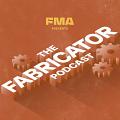
All Episodes
-
 Ep. 053
Ep. 053 -
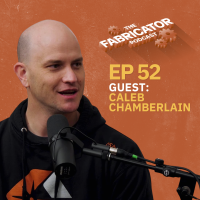 Ep. 052
Ep. 052 -
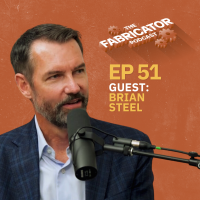 Ep. 051
Ep. 051 -
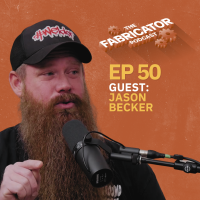 Ep. 050
Ep. 050 -
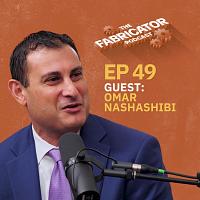 Ep. 049
Ep. 049 -
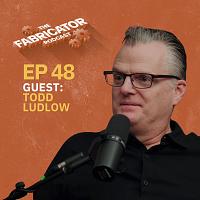 Ep. 048
Ep. 048 -
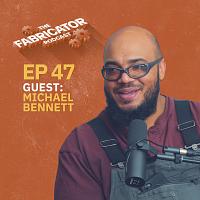 Ep. 047
Ep. 047 -
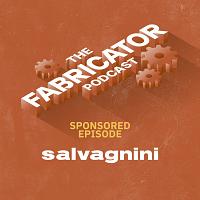 Bonus
Bonus -
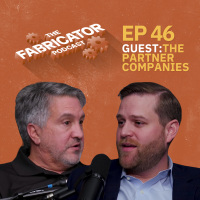 Ep. 046
Ep. 046 -
 Ep. 045
Ep. 045 -
 Ep. 044
Ep. 044 -
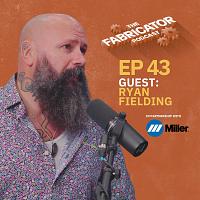 Ep. 043
Ep. 043 -
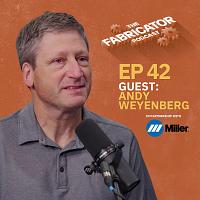 Ep. 042Welding in motorsports with Andy Weyenberg of Miller Electric
Ep. 042Welding in motorsports with Andy Weyenberg of Miller Electric -
 Ep. 041
Ep. 041 -
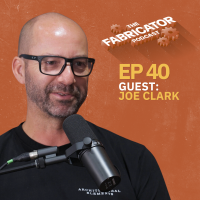 Ep. 040
Ep. 040 -
 Ep. 039
Ep. 039 -
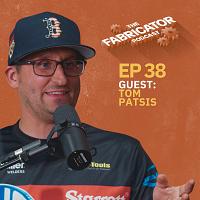 Ep. 038
Ep. 038 -
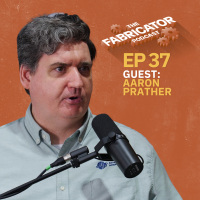 Ep. 037
Ep. 037 -
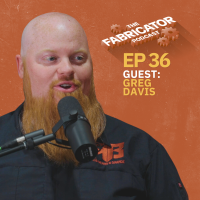 Ep. 036
Ep. 036 -
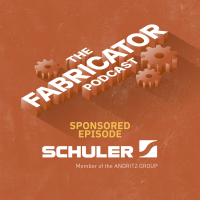 Bonus
Bonus -
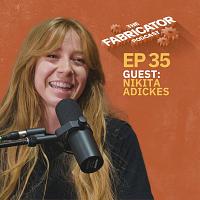 Ep. 035
Ep. 035 -
 Ep. 034
Ep. 034 -
 Ep. 033
Ep. 033 -
 Ep. 032
Ep. 032 -
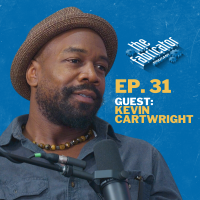 Ep. 031
Ep. 031

























